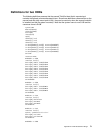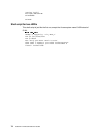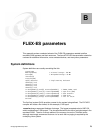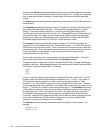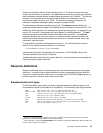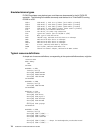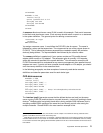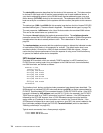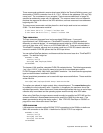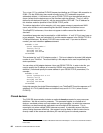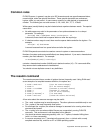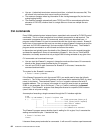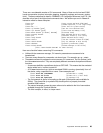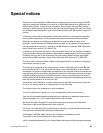Appendix B. FLEX-ES parameters 79
These commands would add a new terminal name (bills) to the Terminal Solicitor screen, and
also enable a TN3270 connection from 9.12.17.211. Where do the addresses (703 and 704)
come from? The cu statement in our example (“Typical resource definitions” on page 76)
specified an addressing range with 16 addresses. The resource name in the cu statement
matches the resource set name of the 3270 definitions, so these resources have addresses
beginning with 700.
The same mount commands could be placed in a shell script used to start an emulated
S/390. The shell statements would be:
$ echo ‘mount 703 bills’ | flexescli localhost S10A
$ echo ‘mount 704 @9.12.17.211’ | flexescli localhost S10A
Tape resources
The tape resources discussed here involve emulated S/390 tapes. If you could
channel-attach “real” S/390 tapes on a ThinkPad/EFS machine, they would be defined
differently, as channel devices. An emulated tape would might be a SCSI-attached device,
such as a 4mm drive, a DLT drive, or an SCSI 3480/3490 unit. These are not available on
ThinkPad/EFS systems, although such a system could use a FLEX-ES network channel to
connect to another FLEX-ES system that has SCSI tape drives.
You can define FakeTape devices, and these would be the normal case for a ThinkPad/EFS
system. The definition might be:
R10A3480: cu 3480
interface local(1)
device(00) 3480 /tmp/tapes/222222
end R10A3480
The keyword 3480 specifies a standard FLEX-ES emulated device. The following parameter,
/tmp/tapes/222222, is the Linux file name to be used for the emulated tape volume.
FLEX-ES supports 3420, 3480, 3490, and 3490-E emulation. You should use the appropriate
type to match whatever is defined in OS/390.
Several specialized parameters can be used with tape resource definitions. These would be
written like this:
device(00) 3480 /tmp/tapes/222222 devopt ‘maxwritesize=200’
The options are placed (in single quotes) after a devopt keyword. The maxwritesize option
is probably the most commonly used. It specifies, in megabytes, the maximum size of the
emulated tape media. When the amount of data written approaches this size, an end-of-tape
reflective strip is emulated and the operating system would normally write EOV labels.
When using FakeTape, the tape resource would normally be specified as OFFLINE and the
operator would use a flexescli mount command to specify the UNIX file to be used. (The
mount command also brings the device online.) See “FLEX-ES FakeTape on OS/390” on
page 45 for more information about FakeTape.
LAN resources
LAN resources are used to define OS/390 TCP/IP connections to the S/390 or to define an
SNA LAN connection to the S/390. A definition for OS/390 TCP/IP use might be:
R10A3088: cu 3172
interface local(1)
device(00) 3172 eth0
device(01) 3172 OFFLINE
end R10A3088



